An Initial Damage Model of Rock Materials under Uniaxial Compression Considering Loading Rates
Abstract
:1. Introduction
2. Experimental Setup
2.1. Specimen Preparation
2.2. Experimental Facility
3. Mechanical Properties and Acoustic Emission Responses
3.1. Mechanical Properties
3.2. Acoustic Emission Responses
4. Construction of Rock Damage Model
4.1. Acoustic Emission Damage Model
4.2. Weibull Strength Theory Damage Model
4.3. Initial Damage Constitutive Model
4.4. Verification of the Initial Damage Constitutive Model
5. Conclusions
Author Contributions
Funding
Institutional Review Board Statement
Informed Consent Statement
Data Availability Statement
Conflicts of Interest
References
- Sun, Q.; Ma, F.; Guo, J.; Zhao, H.; Li, G.; Liu, S.; Duan, X. Excavation-induced deformation and damage evolution of deep tunnels based on a realistic stress path. Comput. Geotech. 2021, 129, 103843. [Google Scholar] [CrossRef]
- Backers, T.; Stanchits, S.; Dresen, G. Tensile fracture propagation and acoustic emission activity in sandstone: The effect of loading rate. Int. J. Rock Mech. Min. Sci. 2005, 42, 1094–1101. [Google Scholar] [CrossRef]
- Backers, T.; Fardin, N.; Dresen, G.; Stephansson, O. Effect of loading rate on Mode I fracture toughness, roughness and micromechanics of sandstone. Int. J. Rock Mech. Min. Sci. 2003, 40, 425–433. [Google Scholar] [CrossRef]
- Zhou, L.; Zhu, Z.; Qiu, H.; Zhang, X.; Lang, L. Study of the effect of loading rates on crack propagation velocity and rock fracture toughness using cracked tunnel specimens. Int. J. Rock Mech. Min. Sci. 2018, 112, 25–34. [Google Scholar] [CrossRef]
- Xing, Y.; Huang, B.; Ning, E.; Zhao, L.; Jin, F. Quasi-static loading rate effects on fracture process zone development of mixed-mode (I-II) fractures in rock-like materials. Eng. Fract. Mech. 2020, 240, 107365. [Google Scholar] [CrossRef]
- Zhao, Y.L.; Zhang, C.S.; Wang, Y.X.; Lin, H. Shear-related roughness classification and strength model of natural rock joint based on fuzzy comprehensive evaluation. Int. J. Rock Mech. Min. Sci. 2021, 137, 104550. [Google Scholar] [CrossRef]
- Yang, H.; Lin, H.; Chen, Y.; Wang, Y.; Zhao, Y.; Yong, W.; Gao, F. Influence of wing crack propagation on the failure process and strength of fractured specimens. Bull. Eng. Geol. Environ. 2022, 81, 71. [Google Scholar] [CrossRef]
- Zhang, C.; Wang, Y.; Jiang, T. The propagation mechanism of an oblique straight crack in a rock sample and the effect of osmotic pressure under in-plane biaxial compression. Arab. J. Geosci. 2020, 13, 736. [Google Scholar] [CrossRef]
- Li, X.; Peng, K.; Peng, J.; Hou, D. Experimental investigation of cyclic wetting-drying effect on mechanical behavior of a medium-grained sandstone. Eng. Geol. 2021, 293, 106335. [Google Scholar] [CrossRef]
- Hashiba, K.; Okubo, S.; Fukui, K. A new testing method for investigating the loading rate dependency of peak and residual rock strength. Int. J. Rock Mech. Min. Sci. 2006, 43, 894–904. [Google Scholar] [CrossRef]
- Okubo, S.; Fukui, K.; Qingxin, Q. Uniaxial compression and tension tests of anthracite and loading rate dependence of peak strength. Int. J. Coal Geol. 2006, 68, 196–204. [Google Scholar] [CrossRef]
- Jeong, H.-S.; Kang, S.-S.; Obara, Y. Influence of surrounding environments and strain rates on the strength of rocks subjected to uniaxial compression. Int. J. Rock Mech. Min. Sci. 2007, 44, 321–331. [Google Scholar] [CrossRef]
- Zhao, F.; Li, Y.; Ye, Z.; Fan, Y.; Zhang, S.; Wang, H.; Liu, Y. Research on Acoustic Emission and Electromagnetic Emission Characteristics of Rock Fragmentation at Different Loading Rates. Shock Vib. 2018, 2018, 321–331. [Google Scholar] [CrossRef]
- Komurlu, E. Loading rate conditions and specimen size effect on strength and deformability of rock materials under uniaxial compression. Int. J. Geo-Eng. 2018, 9, 17. [Google Scholar] [CrossRef]
- Feng, P.; Dai, F.; Liu, Y.; Xu, N.-W.; Du, H.-B. Coupled effects of static-dynamic strain rates on the mechanical and fracturing behaviors of rock-like specimens containing two unparallel fissures. Eng. Fract. Mech. 2019, 207, 237–253. [Google Scholar] [CrossRef]
- Wang, F.; Liu, S.; Cao, L. Research on dynamic compressive behaviors of marble under high strain rates with split Hopkinson pressure bar. J. Struct. Geol. 2020, 138, 104095. [Google Scholar] [CrossRef]
- Wu, J.; Feng, M.; Han, G.; Yao, B.; Ni, X. Loading rate and confining pressure effect on dilatancy, acoustic emission, and failure characteristics of fissured rock with two pre-existing flaws. C. R. Mécanique 2019, 347, 62–89. [Google Scholar] [CrossRef]
- Hokka, M.; Black, J.; Tkalich, D.; Fourmeau, M.; Kane, A.; Hoang, N.-H.; Li, C.; Chen, W.; Kuokkala, V.-T. Effects of strain rate and confining pressure on the compressive behavior of Kuru granite. Int. J. Impact Eng. 2016, 91, 183–193. [Google Scholar] [CrossRef]
- Ma, L.; Wu, J.; Wang, M.; Dong, L.; Wei, H. Dynamic compressive properties of dry and saturated coral rocks at high strain rates. Eng. Geol. 2020, 272, 105615. [Google Scholar] [CrossRef]
- Gong, D.; Nadolski, S.; Sun, C.; Klein, B.; Kou, J. The effect of strain rate on particle breakage characteristics. Powder Technol. 2018, 339, 595–605. [Google Scholar] [CrossRef]
- Malik, A.; Chakraborty, T.; Rao, K.S. Strain rate effect on the mechanical behavior of basalt: Observations from static and dynamic tests. Thin-Walled Struct. 2018, 126, 127–137. [Google Scholar] [CrossRef]
- Mahanta, B.; Singh, T.N.; Ranjith, P.G.; Vishal, V. Experimental investigation of the influence of strain rate on strength; failure attributes and mechanism of Jhiri shale. J. Nat. Gas Sci. Eng. 2018, 58, 178–188. [Google Scholar] [CrossRef]
- Tang, W.; Lin, H.; Chen, Y.; Feng, J.; Hu, H. Mechanical Characteristics and Acoustic Emission Characteristics of Mortar-Rock Binary Medium. Buildings 2022, 12, 665. [Google Scholar] [CrossRef]
- Yulong, C. Experimental research on the acoustic emission characteristics of rock under uniaxial compression. J. China Coal Soc. 2011, 36, 237–240. [Google Scholar]
- Zhang, Y.; Wang, G.; Jiang, Y.; Wang, S.; Zhao, H.; Jing, W. Acoustic Emission Characteristics and Failure Mechanism of Fractured Rock under Different Loading Rates. Shock Vib. 2017, 2017, 5387459. [Google Scholar] [CrossRef]
- Zhang, X.-P.; Zhang, Q.; Wu, S. Acoustic emission characteristics of the rock-like material containing a single flaw under different compressive loading rates. Comput. Geotech. 2017, 83, 83–97. [Google Scholar] [CrossRef]
- Liu, Q.; Deng, P. A numerical investigation of element size and loading/unloading rate for intact rock in laboratory-scale and field-scale based on the combined finite-discrete element method. Eng. Fract. Mech. 2019, 211, 442–462. [Google Scholar] [CrossRef]
- Fan, X.; Yang, Z.; Li, K. Effects of the lining structure on mechanical and fracturing behaviors of four-arc shaped tunnels in a jointed rock mass under uniaxial compression. Theor. Appl. Fract. Mech. 2021, 112, 102887. [Google Scholar] [CrossRef]
- Fan, X.; Jiang, X.; Liu, Y.; Lin, H.; Li, K.; He, Z. Local stress distribution and evolution surrounding flaw and opening within rock block under uniaxial compression. Theor. Appl. Fract. Mech. 2021, 112, 102914. [Google Scholar] [CrossRef]
- Wang, N.; Xu, Y.; Zhu, D.; Wang, N.; Yu, B. Acoustic Emission and Failure Modes for Coal-Rock Structure under Different Loading Rates. Adv. Civ. Eng. 2018, 2018, 9391780. [Google Scholar] [CrossRef]
- Cao, A.; Jing, G.; Ding, Y.-L.; Liu, S. Mining-induced static and dynamic loading rate effect on rock damage and acoustic emission characteristic under uniaxial compression. Saf. Sci. 2019, 116, 86–96. [Google Scholar] [CrossRef]
- Anye, C. Damage evolution law based on acoustic emission of sandy mudstone under different uniaxial loading rate. J. Min. Saf. Eng. 2015, 32, 923. [Google Scholar]
- Zhao, Z.L.; Jing, H.W.; Wu, J.Y.; Shi, X.S.; Gao, Y.; Yin, Q. Experimental investigation on damage characteristics and fracture behaviors of granite after high temperature exposure under different strain rates. Theor. Appl. Fract. Mech. 2020, 110, 102823. [Google Scholar] [CrossRef]
- Chen, Y.; Wen, G.; Hu, J. Analysis of Deformation Characteristics of Fully Grouted Rock Bolts Under Pull-and-Shear Loading. Rock Mech. Rock Eng. 2020, 53, 2981–2993. [Google Scholar] [CrossRef]
- Li, X.; Peng, K.; Peng, J.; Hou, D. Effect of thermal damage on mechanical behavior of a fine-grained sandstone. Arab. J. Geosci. 2021, 14, 1212. [Google Scholar] [CrossRef]
- Zhang, C.; Pu, C.; Cao, R.; Jiang, T.; Huang, G. The stability and roof-support optimization of roadways passing through unfavorable geological bodies using advanced detection and monitoring methods, among others, in the Sanmenxia Bauxite Mine in China’s Henan Province. Bull. Eng. Geol. Environ. 2019, 78, 5087–5099. [Google Scholar] [CrossRef]
- Zhang, C.; Wang, Y.; Ruan, H.; Ke, B.; Lin, H. The strain characteristics and corresponding model of rock materials under uniaxial cyclic load/unload compression and their deformation and fatigue damage analysis. Arch. Appl. Mech. 2021, 91, 2481–2496. [Google Scholar] [CrossRef]
- Zhao, Y.L.; Liu, Q.; Zhang, C.; Liao, J.; Lin, H.; Wang, Y. Coupled seepage-damage effect in fractured rock masses: Model development and a case study. Int. J. Rock Mech. Min. Sci. 2021, 144, 104822. [Google Scholar] [CrossRef]
- Ming, Z. A damage model and statistical analysis of acoustic emission for quasi-brittle materials. Chin. J. Rock Mech. Eng. 2006, 25, 2493–2501. [Google Scholar]
- Fangle, P. Elasto-viscoplastic constitutive model of sandy soil considering stress path and loading rate. Chin. J. Rock Mech. Eng. 2009, 28, 929–938. [Google Scholar]
- Zhao, K.; Yu, X.; Zhou, Y.; Wang, Q.; Wang, J.; Hao, J. Energy evolution of brittle granite under different loading rates. Int. J. Rock Mech. Min. Sci. 2020, 132, 104392. [Google Scholar] [CrossRef]
- Yang, L.; Wang, G.; Zhao, G.-F.; Shen, L. A rate- and pressure-dependent damage-plasticity constitutive model for rock. Int. J. Rock Mech. Min. Sci. 2020, 133, 104394. [Google Scholar] [CrossRef]
- Qi, C.; Wang, M.; Qian, Q. Strain-rate effects on the strength and fragmentation size of rocks. Int. J. Impact Eng. 2009, 36, 1355–1364. [Google Scholar] [CrossRef]
- Saksala, T.; Hokka, M.; Kuokkala, V.-T. Numerical 3D modeling of the effects of strain rate and confining pressure on the compressive behavior of Kuru granite. Comput. Geotech. 2017, 88, 1–8. [Google Scholar] [CrossRef]
- Bieniawski, Z.T.; Bernede, M.J. Suggested methods for determining the uniaxial compressive strength and deformability of rock materials: Part1. Suggested method for determination of the uniaxial compressive strength of rock materials. Int. J. Rock Mech. Min. Sci. Geomech. Abstr. 1979, 16, 138–140. [Google Scholar] [CrossRef]
- Zhang, J. Investigation of Relation between Fracture Scale and Acoustic Emission Time-Frequency Parameters in Rocks. Shock Vib. 2018, 2018, 3057628. [Google Scholar] [CrossRef]
- Zhang, G.; Li, H.; Wang, M.; Li, X.; Wang, Z.; Deng, S. Crack-induced acoustic emission and anisotropy variation of brittle rocks containing natural fractures. J. Geophys. Eng. 2019, 16, 599–610. [Google Scholar] [CrossRef]
- Shouwen, Y.; Xiqiao, F. Damage Mechanics; Tsinghua University Press: Beijing, China, 1997. [Google Scholar]
- Lemaitre, J. How to Use Damage Mechanics. Nucl. Eng. Des. 1984, 80, 233–245. [Google Scholar] [CrossRef]
- Ming, J.; Yidong, Z. Damage evolution law based on acoustic emission and weibull distribution of granite under uniaxial stress. Acta Geodynet Geomater 2014, 11, 269–277. [Google Scholar]
- Chao, Z. Study on the whole process simulation method of brittle rocks deformation and failure considering initial voids closure and its influence. J. China Coal Soc. 2020, 3, 1044–1052. [Google Scholar]
- Xiulei, L. A statistical damage model for rock full deformation process with considering the characteristics of initial void compaction. J. Southwest Jiaotong Univ. 2021, 38, 1754–1761. [Google Scholar]
- Wengui, C. Statistical damage simulation method of strain softening deformation process for rocks considering characteristics of void compaction stage. Chin. J. Geotech. Eng. 2016, 38, 1754–1761. [Google Scholar]
- Zhang, H.; Guo, P.Y.; Wang, Y.; Zhao, Y.; Lin, H.; Liu, Y.; Shao, Y. Fracture Behavior of Rock with Initial Damage: Theoretical, Experimental, and Numerical Investigations. Geofluids 2020, 2020, 8886843. [Google Scholar] [CrossRef]
- Yang, J.; Mu, Z.-L.; Yang, S.-Q. Experimental study of acoustic emission multi-parameter information characterizing rock crack development. Eng. Fract. Mech. 2020, 232, 107045. [Google Scholar] [CrossRef]
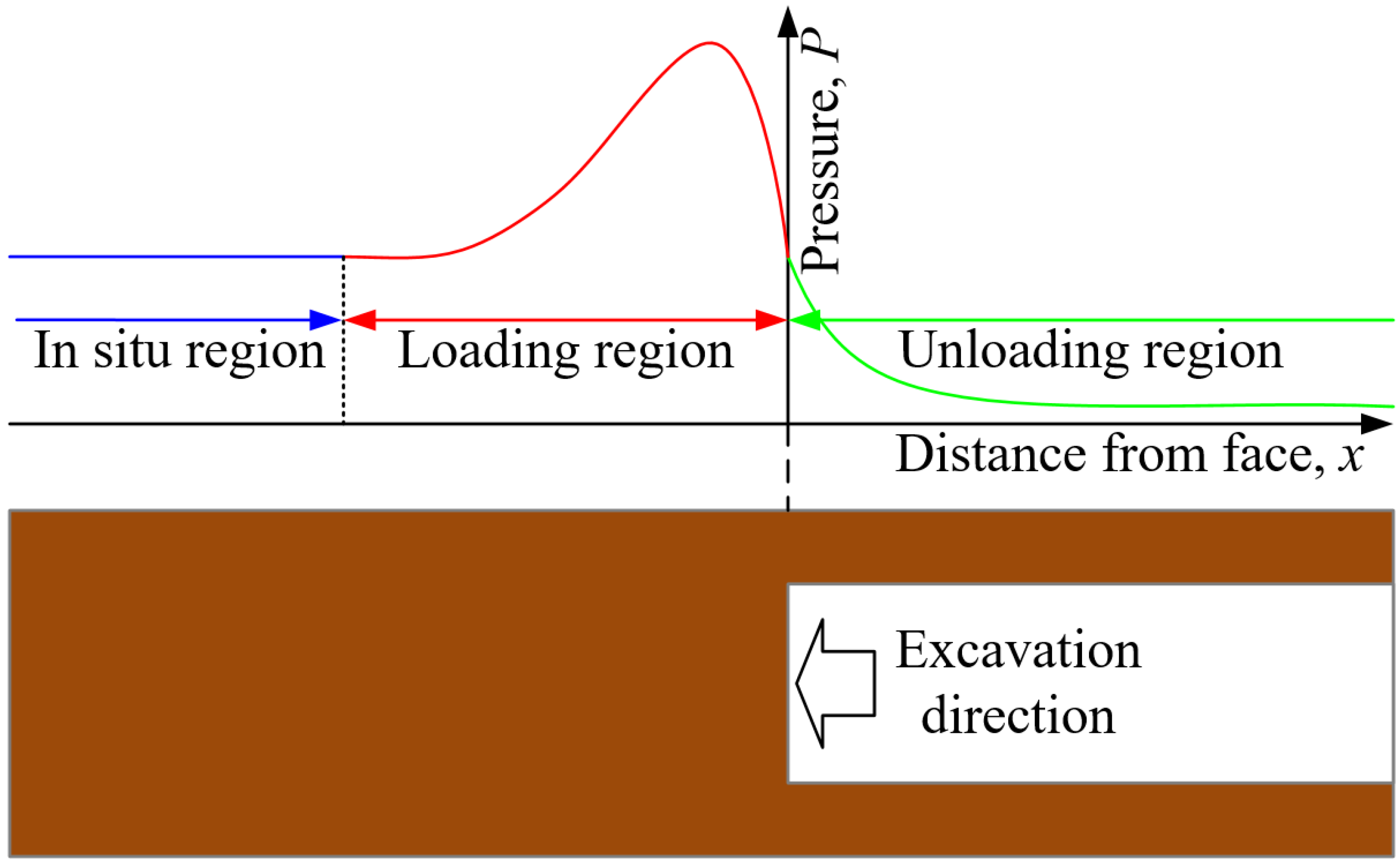
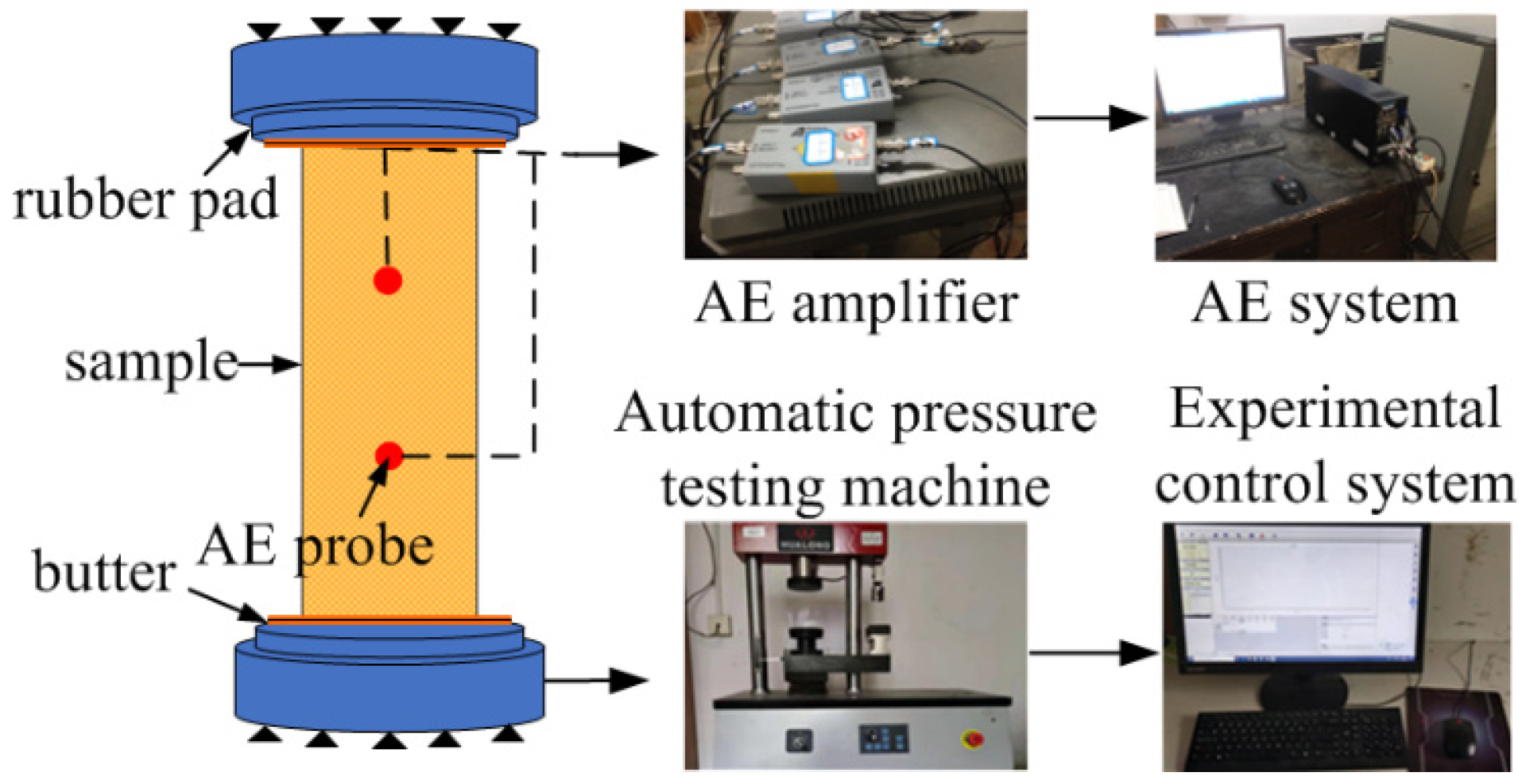
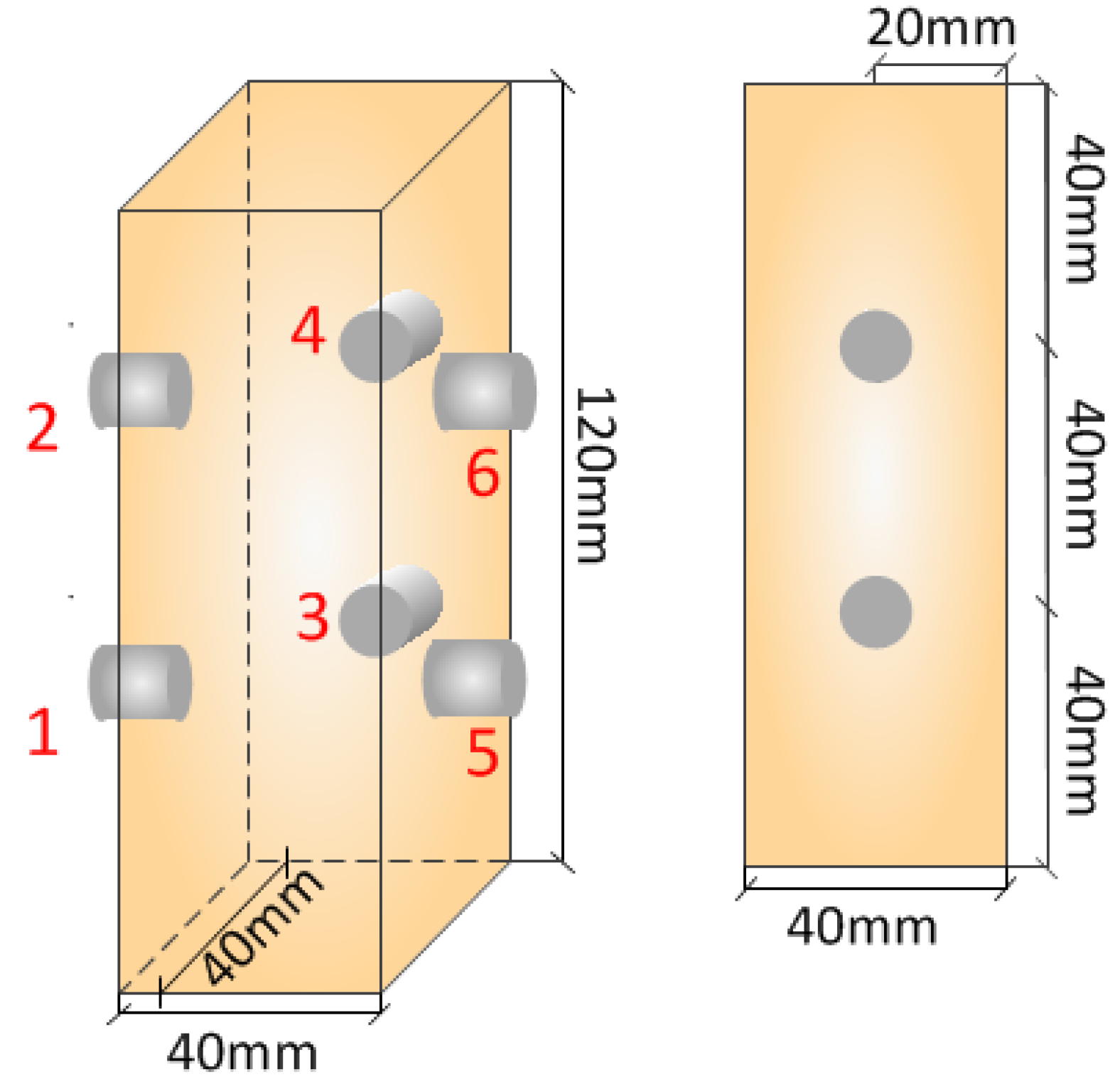
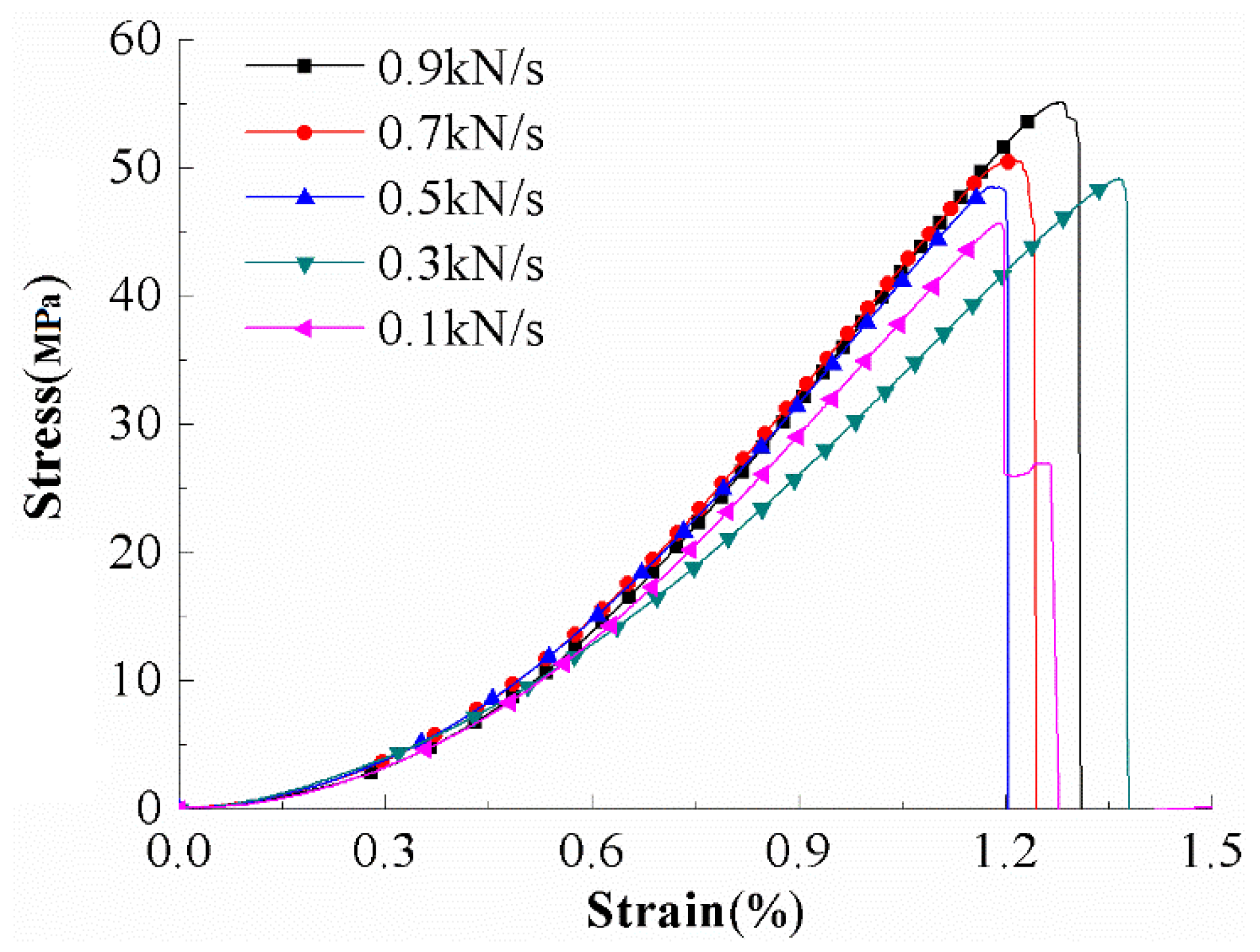
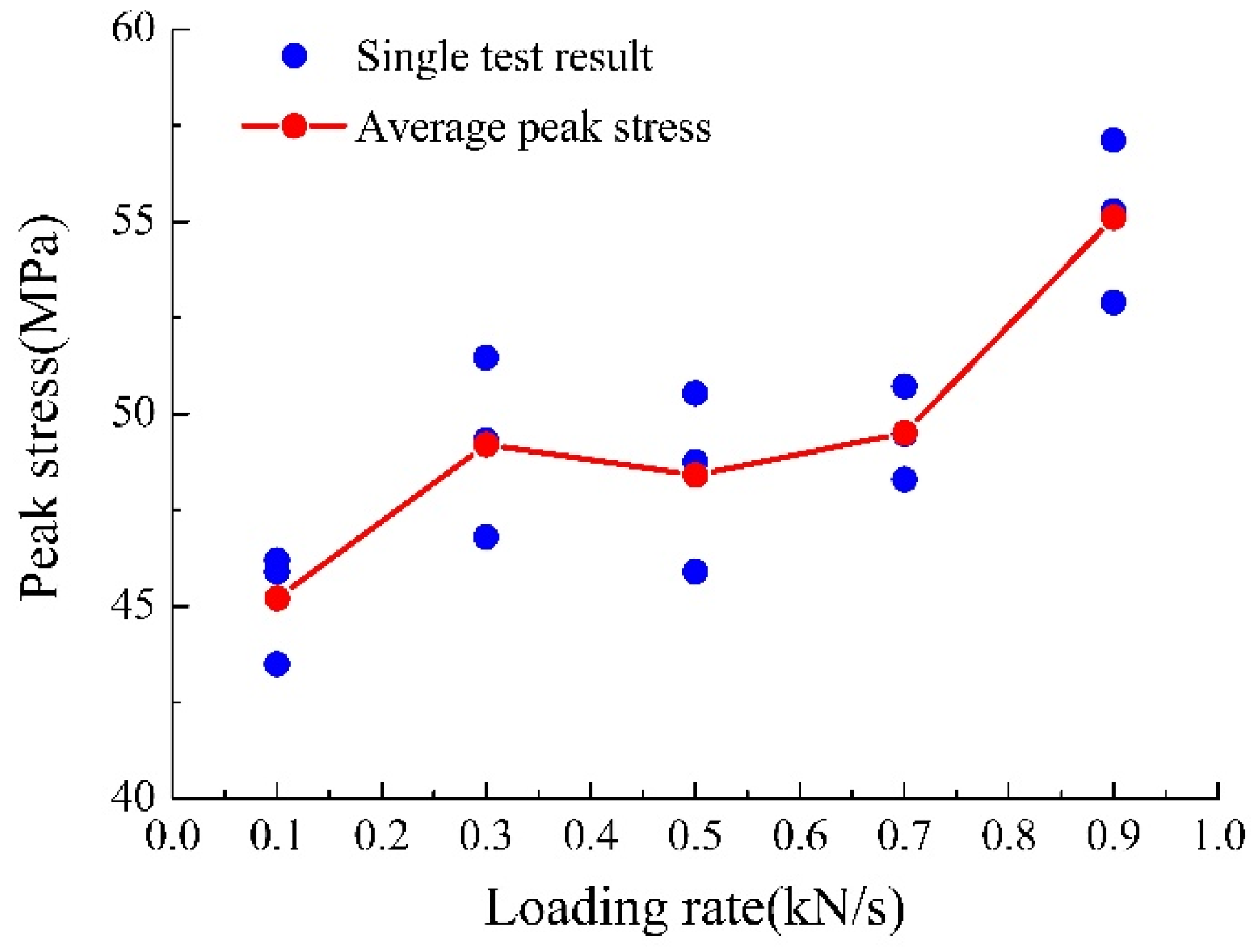

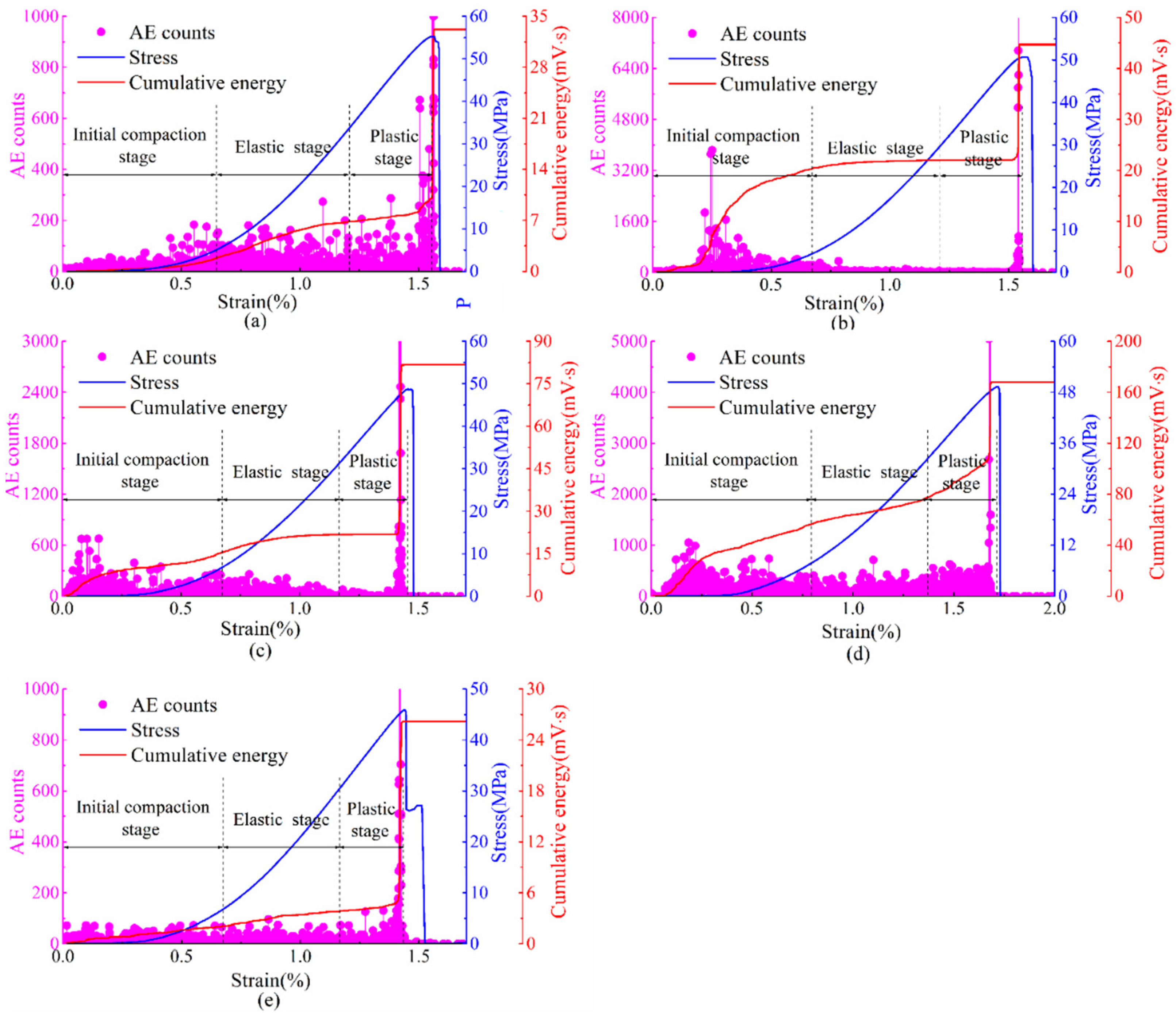
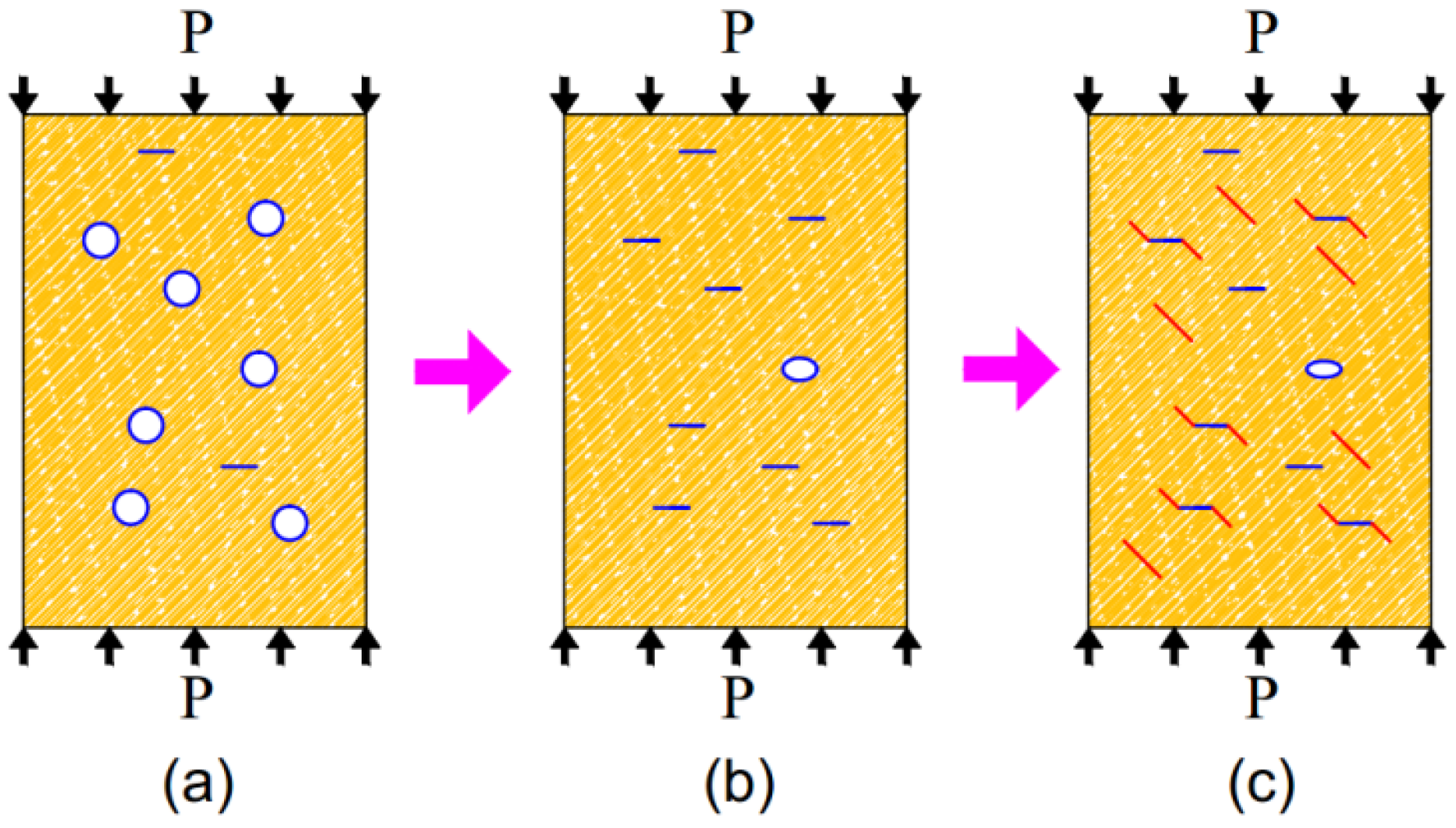
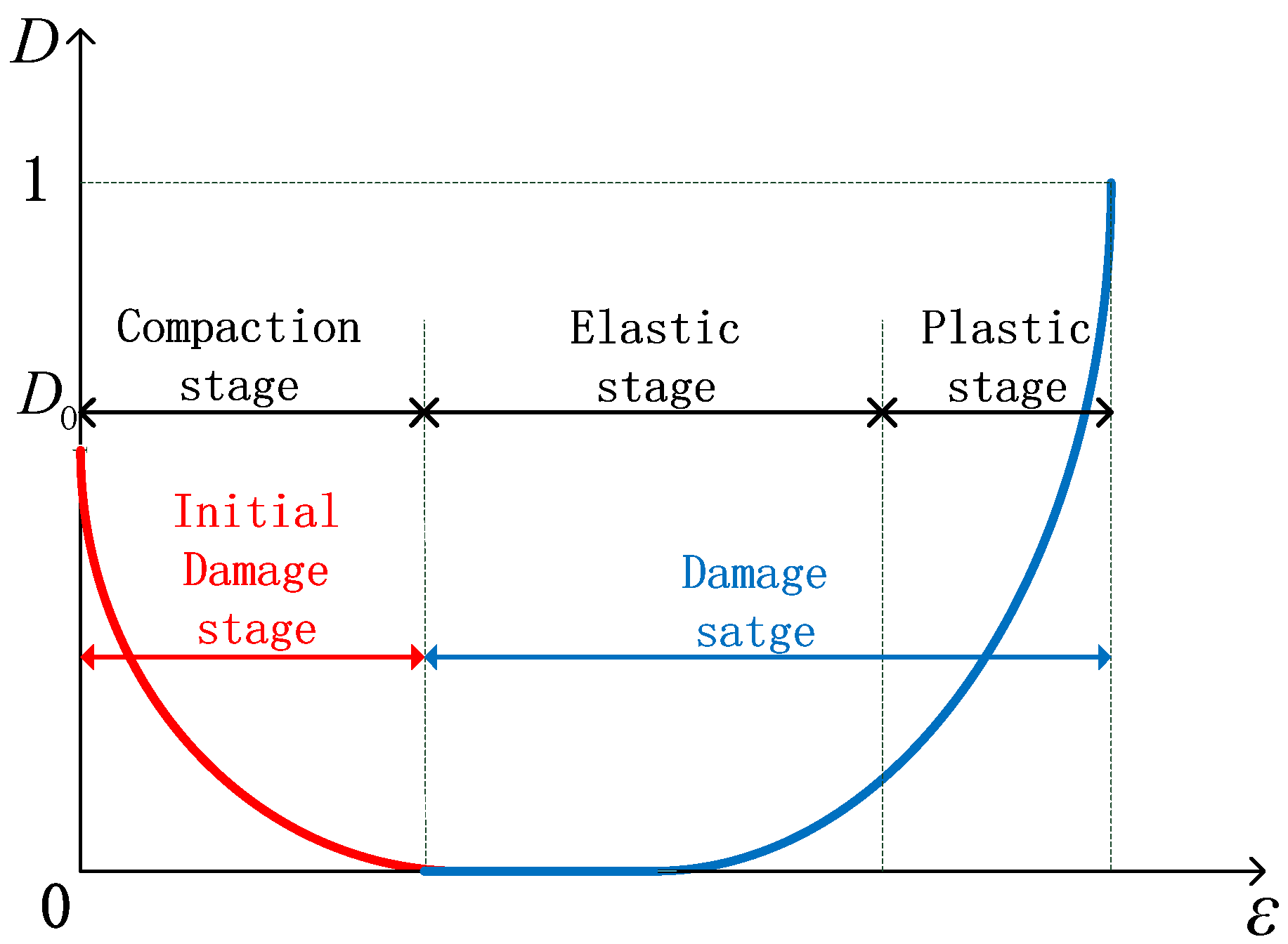
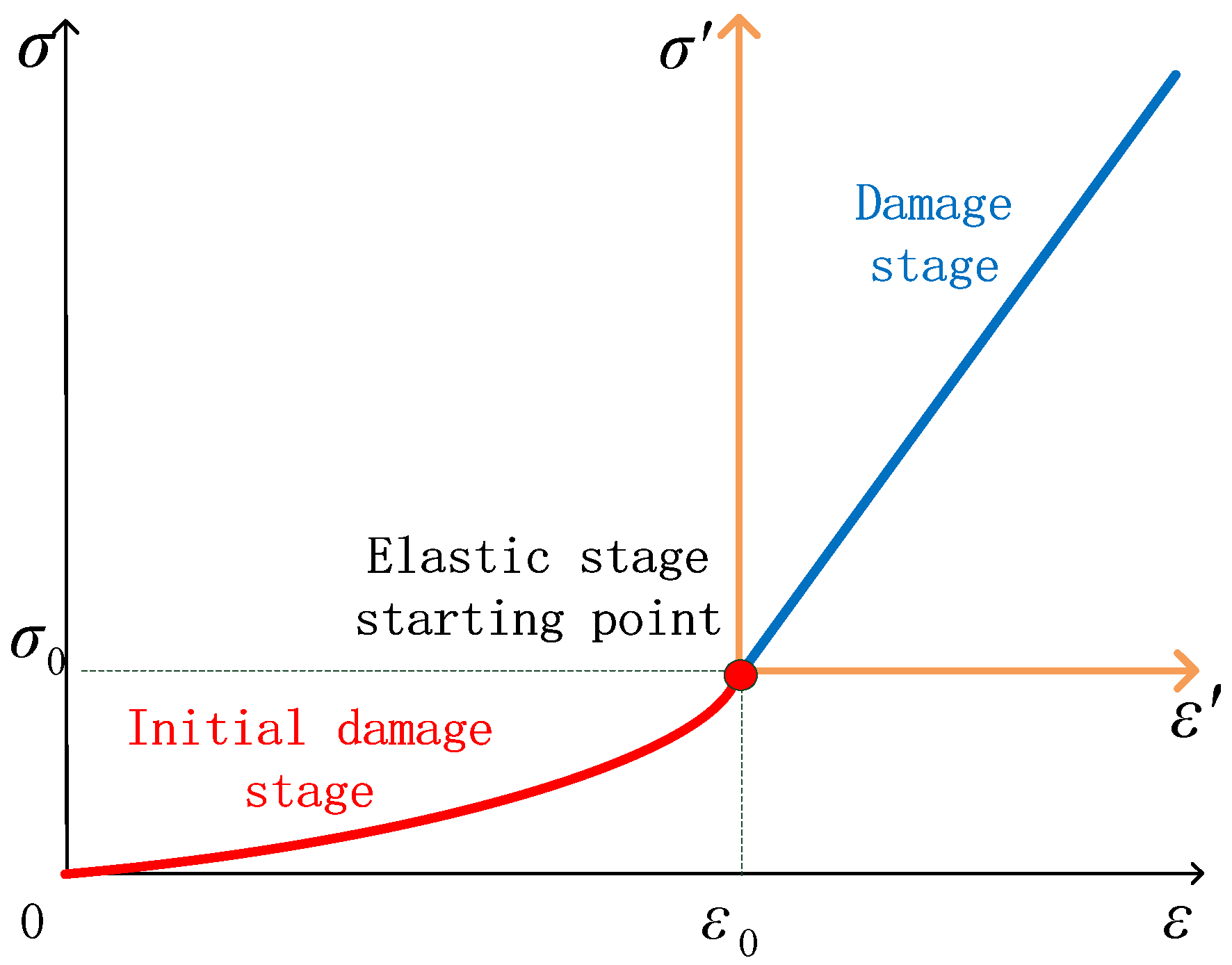
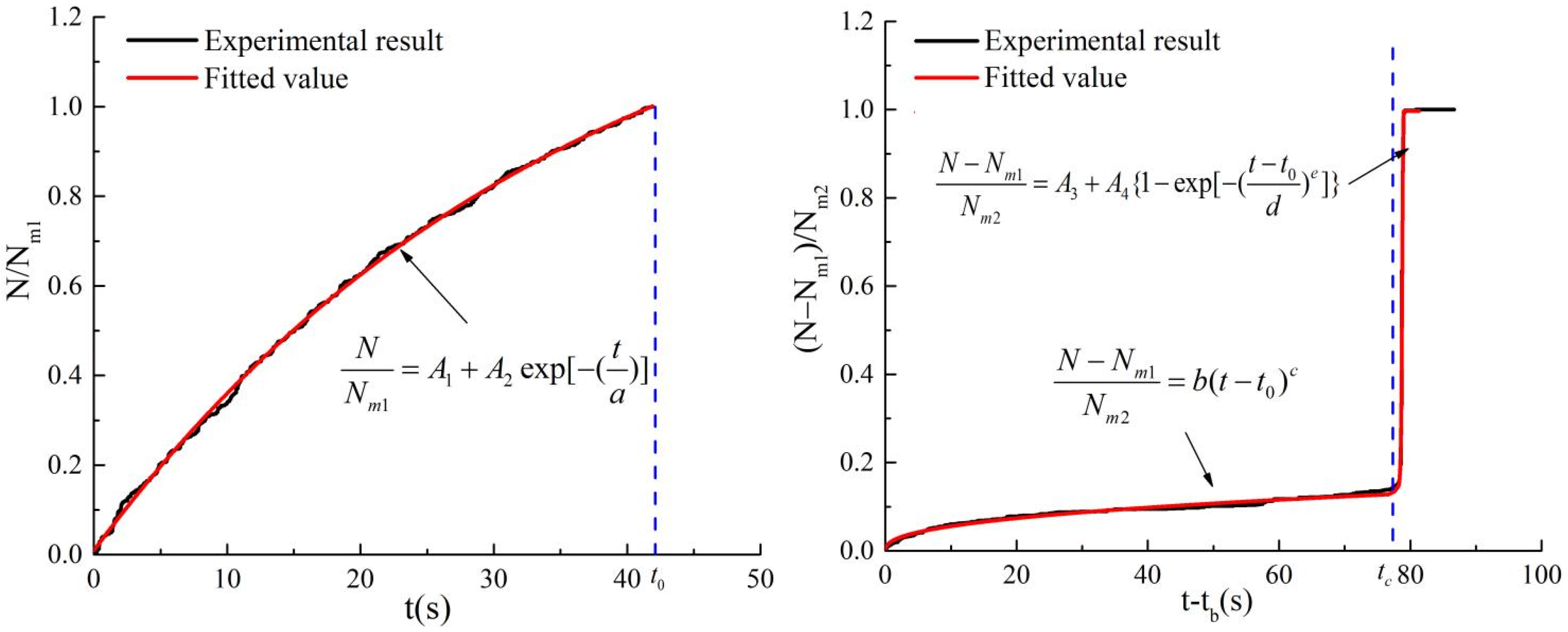
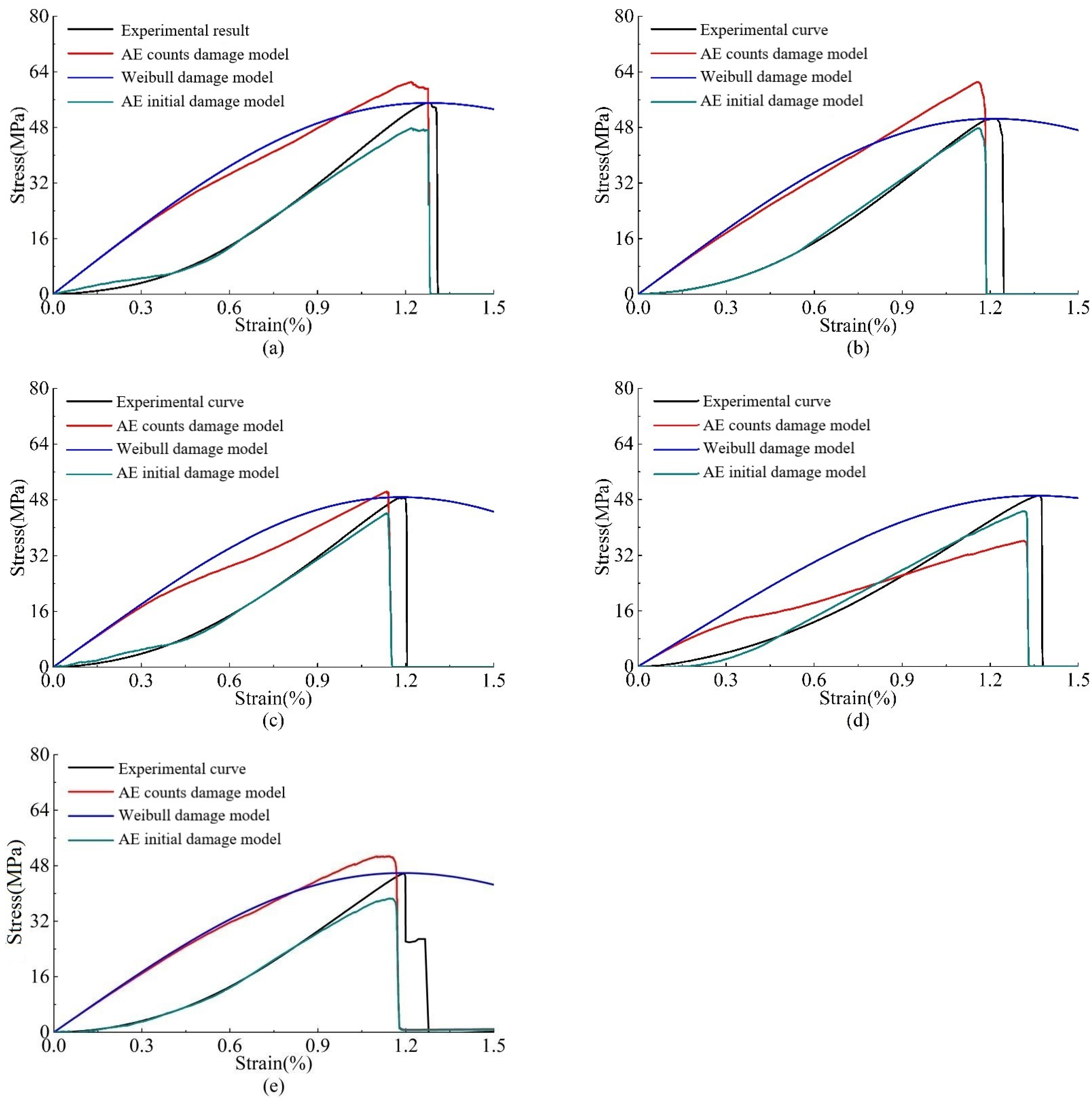
| Loading Rate (kN/s) | 0.1 | 0.3 | 0.5 | 0.7 | 0.9 |
|---|---|---|---|---|---|
| 0.591 | 0.626 | 0.572 | 0.637 | 0.624 |
| Loading Rates (kN/s) | Fitted Parameters | ||||||||
|---|---|---|---|---|---|---|---|---|---|
| 0.1 | 1.463 | −1.443 | 47.466 | 0.024 | 0.680 | 0.130 | 0.874 | 96.330 | 436.378 |
| 0.3 | 1.430 | −1.458 | 38.246 | 0.017 | 0.330 | 0.073 | 0.838 | 63.596 | 378.388 |
| 0.5 | 1.446 | −1.436 | 35.746 | 0.014 | 0.340 | 0.035 | 0.964 | 88.018 | 160.209 |
| 0.7 | 1.097 | −1.100 | 6.004 | 0.021 | 0.401 | 0.142 | 0.855 | 78.784 | 681.369 |
| 0.9 | 1.480 | −1.401 | 21.925 | 0.002 | 1.077 | 0.147 | 0.848 | 46.706 | 203.098 |
Publisher’s Note: MDPI stays neutral with regard to jurisdictional claims in published maps and institutional affiliations. |
© 2022 by the authors. Licensee MDPI, Basel, Switzerland. This article is an open access article distributed under the terms and conditions of the Creative Commons Attribution (CC BY) license (https://creativecommons.org/licenses/by/4.0/).
Share and Cite
Meng, G.; Liu, Z.; Cao, P.; Zhang, Z.; Fan, Z.; Lin, H.; Deng, H. An Initial Damage Model of Rock Materials under Uniaxial Compression Considering Loading Rates. Materials 2022, 15, 5589. https://doi.org/10.3390/ma15165589
Meng G, Liu Z, Cao P, Zhang Z, Fan Z, Lin H, Deng H. An Initial Damage Model of Rock Materials under Uniaxial Compression Considering Loading Rates. Materials. 2022; 15(16):5589. https://doi.org/10.3390/ma15165589
Chicago/Turabian StyleMeng, Gang, Zhizhen Liu, Ping Cao, Ziyang Zhang, Zhi Fan, Hang Lin, and Huijuan Deng. 2022. "An Initial Damage Model of Rock Materials under Uniaxial Compression Considering Loading Rates" Materials 15, no. 16: 5589. https://doi.org/10.3390/ma15165589
APA StyleMeng, G., Liu, Z., Cao, P., Zhang, Z., Fan, Z., Lin, H., & Deng, H. (2022). An Initial Damage Model of Rock Materials under Uniaxial Compression Considering Loading Rates. Materials, 15(16), 5589. https://doi.org/10.3390/ma15165589







